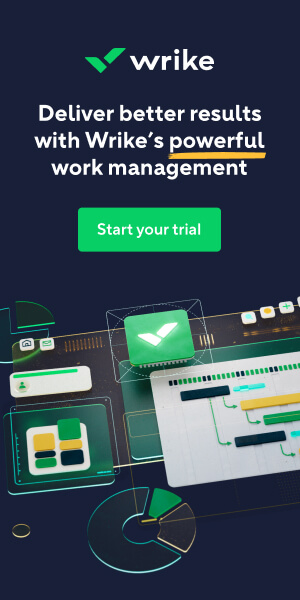Projects are made up of milestones, deliverables, and tasks brought together to accomplish goals and objectives. To effectively plan and monitor timely project completions, you’ll need clarity on the factors that contribute to its success. One of the ways you can stay on top of these is by creating a work breakdown structure (WBS).
What is a Work Breakdown Structure (WBS)?
A work breakdown structure is a list of a project’s deliverables broken down into smaller ones.
Work breakdown structure levels
You can make your work breakdown structure as detailed as you want:
- Level 0: Project title or final deliverable
- Level 1: Major deliverables
- Level 2: Deliverables that can still be broken down
- Level 3: Can be assigned to the team to complete the third level deliverables
Here’s an example that illustrates this:

Work breakdown structure formats
The format of your WBS will depend on your team’s or stakeholders’ preferences.
Tree
The illustration we showed previously is an example of a WBS formatted as a tree. It’s the most commonly used, and it uses rectangles and line connectors to illustrate how the elements relate to one another.
Outline
The outline is the simplest you can do. It’s text-based, and it represents deliverable hierarchies through indents and numbering.
If your level 2 deliverable is numbered as 1, then the level 3 deliverables under it will be labeled as 1.1, 1.2, 1.3, etc. Here’s an example:

Tabular
A tabular WBS uses tables to display the hierarchy among tasks. The leftmost column will contain the major deliverables. The succeeding columns after that will house the next deliverable levels.
Here’s how we can illustrate that with the Halloween Party example:

Hierarchical
The hierarchical WBS is also shown in a tabular form. The difference would be how the information is organized.

In this format, the leftmost column would contain the Level, the second would be the WBS Code, and the last would be the Deliverable.
Work breakdown structure types
The information on its second level primarily determines the type of WBS. The ones illustrated above are delivery-based WBS, in which the second level represents the key deliverables for the project.
Another type, phase-based WBS, uses the project phases as the elements for level 2.
Here’s a trimmed example of the Halloween Party WBS turned into a phase-based WBS:

Your industry and project type will dictate the WBS you should use.
Go more in-depth with WBS Types (Work Breakdown Structure)
How to Make a Work Breakdown Structure
A work breakdown structure can be made by taking the following steps:
- Collect Information on Project Goals and Deliverables: Before creating your work breakdown structure, go over your project’s goals and final deliverable. Study your scope and limitations to identify the steps you need to take to make progress.
- Gather Key Stakeholders and Team Members: Once you have the information you need, share them with your team and stakeholders, so you can check and balance what you know.
- Define Elements: With your team, start filling in your WBS with a breakdown of your deliverables.
- Add Additional Details: You can opt to add additional details, such as the person assigned and your budget for each deliverable.
Advantages of a Work Breakdown Structure
Some of the advantages of a work breakdown structure include:
- Identifying Deliverable Allows for Thorough Project Planning: Creating a work breakdown structure will require you and your team to identify your deliverables and break them down into the actionable ones you will need to work on daily and weekly.
- Facilitates Focus for Team Members and Improves ivity: Seeing what the team has to accomplish in days and weeks makes it easier to focus on day-to-day work. While long-term goals are important, short-term goals give teams actionable aims.
- Establishes Relationships Between Deliverables: Because dependencies are on full display with a work breakdown structure, it’s easy to spot which major deliverables are affected when smaller activities are neglected.
Limitations of a Work Breakdown Structure
Needs to be supported by other tools for maximum effectivity
While a work breakdown structure can display a lot of information, it doesn’t display how challenging the tasks are. Aside from the budget, you also won’t find the resources your team will need to accomplish them. To effectively use the WBS, use them with other tools.
Could encourage micromanagement
It can be tempting for project managers to micromanage teams when their respective deliverables are easily visible.
How should your WBS differ for an IT project? Read Work Breakdown Structure for IT Projects (WBS)
Complementing Project Plans with a Work Breakdown Structure
A work breakdown structure offers a great way to increase the visibility of a project’s deliverables. It can be displayed in the form of a tree, outline, table, or hierarchy. You can also make it as detailed as you want it to be.
While there are a few limitations, using a WBS to complement your project’s processes can enable you to better manage your team’s focus and improve your project estimates.
WBS best practices
Project teams can make sure that their WBS are comprehensive and realistic with the help of some best practices to guide them.
Follow the 100% rule
The WBS should represent 100 percent of the work necessary to complete the project. So, every major and minor deliverable constitute a percentage that when summed up results to 100 percent. This also means that you should avoid duplication so that every item in the WBS is mutually exclusive and helps you plan for resources accurately.
Keep your eye on outcomes, not actions
Focus on outcomes and deliverables, not actions. Outcomes are the desired ends of the project such as a product, service, or result.
Keep an eye on the 8/80 rule
Follow the 8/80 rule to ensures that no task is less than 8 hours or more than 80 hours in the WBS. If a task is greater than 80 hours then you need to decompose it further into lower-level work packages.
Keep sharpening the saw
The art and science of project management have likely changed since you got your last certification. While experience and instinct are both valuable assets in your PM toolbox, you need to keep up with best practices and new methodologies. A great place to start is with TechRepublic Academy.












